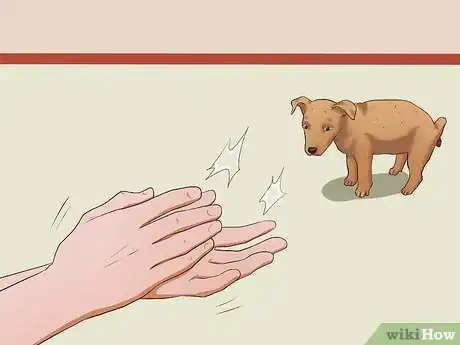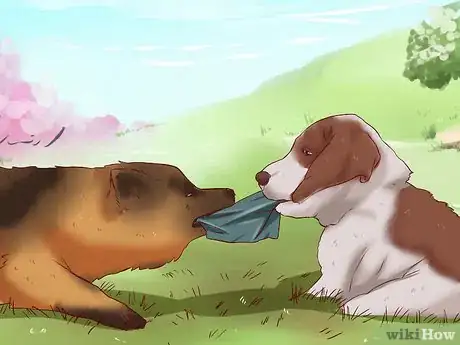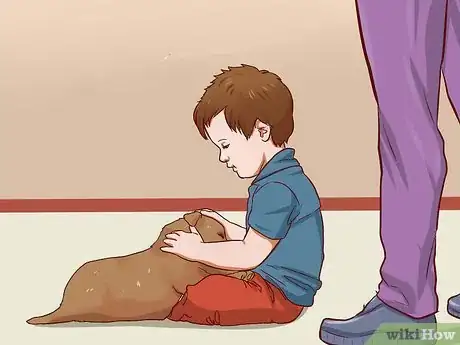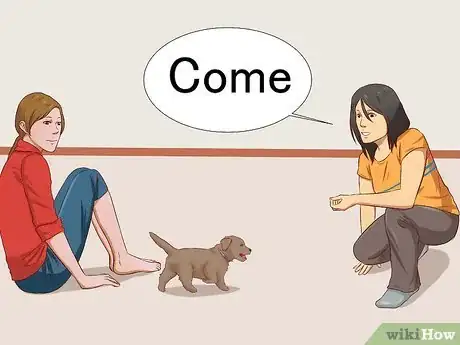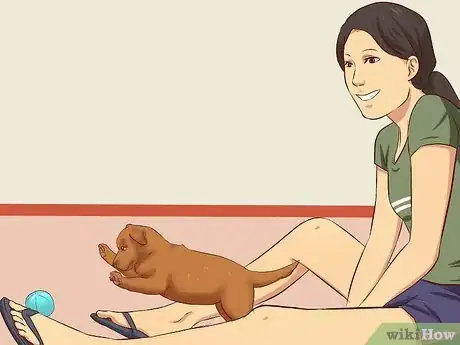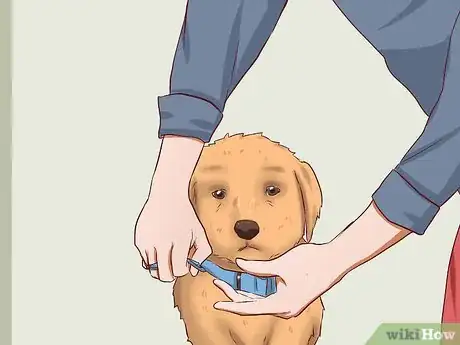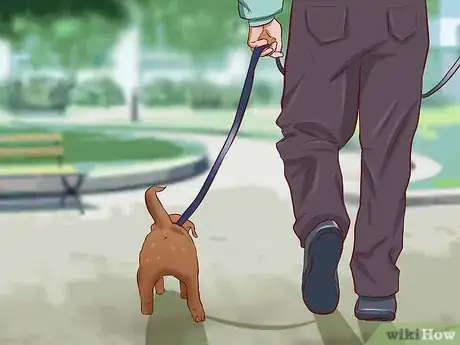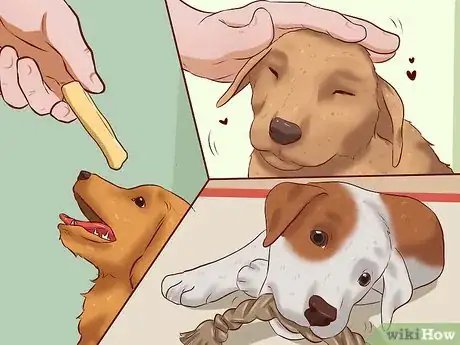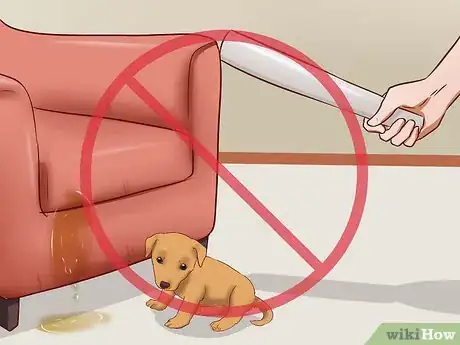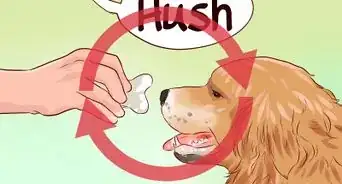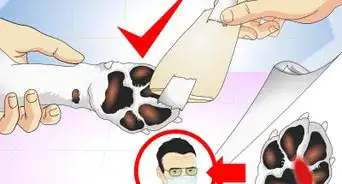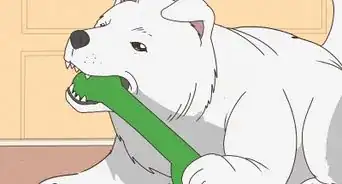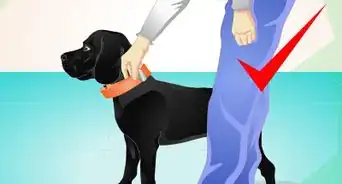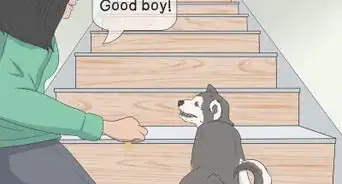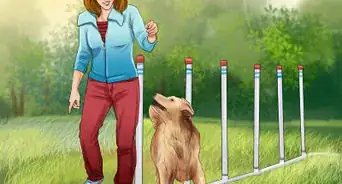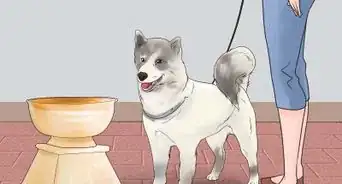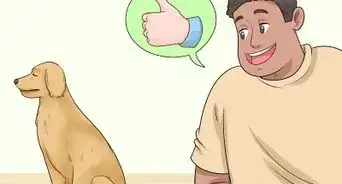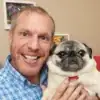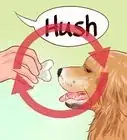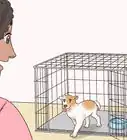This article was co-authored by Brian Bourquin, DVM. Brian Bourquin, better known as “Dr. B” to his clients, is a Veterinarian and the Owner of Boston Veterinary Clinic, a pet health care and veterinary clinic with three locations, South End/Bay Village, the Seaport, and Brookline, Massachusetts. Boston Veterinary Clinic specializes in primary veterinary care, including wellness and preventative care, sick and emergency care, soft-tissue surgery, dentistry. The clinic also provides specialty services in behavior, nutrition, and alternative pain management therapies using acupuncture, and therapeutic laser treatments. Boston Veterinary Clinic is an AAHA (American Animal Hospital Association) accredited hospital and Boston’s first Fear Free Certified Clinic. Brian has over 19 years of veterinary experience and earned his Doctor of Veterinary Medicine from Cornell University.
There are 11 references cited in this article, which can be found at the bottom of the page.
wikiHow marks an article as reader-approved once it receives enough positive feedback. In this case, 100% of readers who voted found the article helpful, earning it our reader-approved status.
This article has been viewed 313,559 times.
Puppies need to be trained how to do many things in order to be good dogs. It is up to you to teach your puppy how to play nice, go potty in a designated place in the yard, and walk beside you on a leash. It may take several months of focused attention to teach a puppy how to do all of these things. Use a firm but gentle training style to guide your puppy through the lessons she needs to learn, and before you know it she will grow into a mature, well-behaved dog with a special place in your family.
Steps
Housetraining a Puppy
-
1Develop a routine for your puppy. To begin housetraining your puppy, create a routine to help your puppy learn. Puppies need a consistent routine in order to learn when and where they are supposed to relieve themselves. It's important to start teaching your puppy to go outside when she feels the urge as soon as you bring her home. Plan to take her outside on a set schedule every day: first thing in the morning, after every meal, after playtime, and right before bed.[1]
- Puppies should be taken out every hour, as well as shortly after meals, naps, and playtime. You should always take your puppy out first thing in the morning, before you and the puppy go to bed at night, and before you leave the puppy alone for any extended period of time.
- Feed your puppy at the same time every day so you can predict when she'll need to go outside.
- Very young puppies have to go to the bathroom as often as once an hour.[2] That means you or a family member will need to be available to take your puppy outside that often.
- If you aren't available to housetrain your puppy during the day, it's important to hire someone else to do it professionally. If you don't start early, it may take your dog a long time to learn not to go to the bathroom in the house.
-
2Get your puppy’s attention if she tries to eliminate in the house. If you notice your puppy going potty inside the house, don't overreact by yelling at her or scaring her. Interrupt her while she's doing her business by clapping your hands together. Then pick her up or get her to follow you right away and take her to her bathroom spot. When she finishes going to the bathroom there, reward her with some praise.[3]
- If you find a mess behind the sofa or somewhere else in your house, it's too late to discipline the puppy. Don't rub her nose in it; she'll just get confused and scared, and she won't understand what you're trying to teach her.
Advertisement -
3Limit your puppy’s space within your home while your puppy is housetraining. For the first few months you will need to keep a careful eye on your puppy so that you can take her outside as soon as she has to go to the bathroom. If you give her too much freedom around the house at first, she'll learn to go to the bathroom wherever she wants, and you won't always be able to catch it in time.[4]
- Use baby gates to limit your puppy’s area within your home. For example, you could put a gate up at the bottom of the stairs to prevent your puppy from roaming around the upper level of your home or put gates up to limit your puppy’s movement between a couple of rooms in your home. Allow your puppy more freedom as she becomes better at controlling her bladder and bowels.[5]
- Try putting your puppy on a leash when she is exploring a new room. It will be much more difficult for your puppy to get into trouble when you are attached to the other end of the leash.
-
4Pick a designated bathroom spot outside. Having a place that the puppy associates with going to the bathroom will help her learn not to go in the house. She'll start wanting to go to that spot to relieve herself, and over time she'll learn to wait until you take her there instead of going to the bathroom inside.[6]
- Use language to strengthen the puppy's association with the spot. Say "go potty" or just "potty" when you set her down. Don't use the word anywhere but in that spot.
- Many people choose a far corner of the yard, sometimes a place that is fenced off, as the spot where their dog goes to the bathroom. If you don't have a yard, choose a spot close to your home or apartment. It doesn't matter where the location is as long as you take your puppy to the same spot every time.
- Bringing her to the same spot will associate the smells of the spot with going potty. Smells can often prompt a puppy to eliminate.
- Keep in mind that some puppies will go potty as soon as you take them outside, while others may need to move around a play a bit before they can eliminate.
-
5Praise your puppy for a job well done. When the puppy successfully goes to the bathroom in her designated spot, praise her, pet her and give her a treat. Doing so will help your puppy to understand that this is good behavior and that she should keep doing it.[7] The promise of a reward will encourage her to perform the same good behavior again.
- Give your puppy her reward immediately after she goes to the bathroom and while she's still in her bathroom spot. If you wait, she'll associate the praise with something else.
- Wait until your puppy finishes going potty. If you praise your puppy before she has gone to the bathroom, she may get confused.
-
6Clean messes up right away. Your puppy will have accidents from time to time and it is important to clean them up right away. Cleaning up your puppy’s messes right away will to help prevent further messes in your house.[8]
- Use an enzymatic cleaner rather than an ammonia-based cleaner to clean up your puppy’s messes right after they happen. Ammonia based cleaners smell too much like urine, so your puppy may confuse the smell with her own urine. If the area smells like urine, your puppy may want to go to the bathroom there again.[9]
-
7Consider crate training your puppy. A crate helps with potty training because dogs do not like to soil their dens. A crate should be a safe place where your puppy can retreat to during the day if she becomes overwhelmed or that she can go to feel safe when you are away.[10]
- Make sure the crate is big enough for her to stand up in and lie down with her legs stretched out. If it is too much bigger than this, then she may choose a corner of the crate as a bathroom spot.
- Make sure not to use the crate as a punishment. Take her out regularly for a game or to offer a toilet break.
Training a Puppy to Play Nicely
-
1Let your puppy play with other puppies. Puppies learn how to socialize by playing with other puppies. Very young puppies don't know that they can hurt others with their teeth. They learn by playing; when one puppy bites another puppy too hard, the puppy yelps and stops playing. In this way, puppies learn to control how hard they bite.[11]
-
2Discourage your puppy from biting you. Play with your puppy the way another puppy would; by tickling her and wrestling with her until she starts to nip at you. When she bites your hand, let out a high-pitched yelp, just the way another puppy would. Let your hand go limp and stop playing. Your puppy will learn that when she bites, she doesn't get attention anymore.
- Your puppy may try to making up for the bite by nuzzling and licking your hand. Praise her in a sweet voice and reward her with a treat, then keep playing with her. She'll learn that playing nicely gets rewarded.[12]
- Never spank a puppy to cause her pain in return. Using physical punishment against a puppy will only make her afraid of you.
-
3Give your puppy chew toys. Puppies love to use their teeth, and they have to be taught that human skin is not for chewing. Provide plenty of puppy-safe chew toys for your puppy to gnaw on during play time.
- When your puppy starts nipping at your skin, put a chew toy in her mouth. This will teach her that she should be chewing on the toy instead of your hand.
- Do the same thing if your puppy nips at your heels and ankles when you walk around. Stop walking and give her a chew toy. If you don't have a toy handy, just stop. When she starts playing nicely, praise her.
- If she grabs something of yours, distract her and swap the item for one of her own toys in its place.
-
4Employ a time-out area. If your puppy is having trouble learning not to bite, you may need to create a time-out area, a place where you take her to teach her that if she can't play nice, she doesn't get to play. Set aside a corner of her playroom and take her there right away when she bites.
- Don't use the puppy's crate as a time-out area. She should never associate being crated with punishment.
- After your puppy has been in time out for a few minutes, bring her back to play with the family. Reward her when she plays nicely. If she bites again, give a high-pitched yelp and take her right back to time out. Eventually she will learn not to bite.
-
5Teach your puppy to play well with children. Children move quickly, make high-pitched noises and are often on face level with puppies. Puppies and children can have a lot of fun together, but they have to be taught to play properly. If your puppy gets rough with a child, put her in time out immediately. Make sure your kids know how to play nicely, too.
- Always supervise your children around your puppy. Make sure that your children know that puppies are fragile and teach them what to do if the puppy nips or gets too rough.[13]
Teaching a Puppy to Sit, Stay and Come
-
1Start by teaching your puppy her/his name. In order to train your puppy effectively, make sure she knows her name. Say her name clearly. When she looks at you, give her a treat. Continue doing so until she learns that when you say her name, she should look at you. Now you can use her name before issuing other commands.
-
2Teach your puppy to sit. This is one of the easiest behaviors to teach a puppy, and almost any puppy can learn how to do it. The trick is to get your puppy to associate the act of placing her bottom on the floor with the sound of your voice saying "sit." Tell her to "sit" in a clear, firm but friendly voice. When she does, give her a treat.[14]
- Practice often. Sitting can be practiced inside, outside, and anywhere you take your puppy. Carry treats with you so you can turn any moment into a training session.
- Eventually phase out the treats so that your puppy can sit on command without a reward.
-
3Teach your puppy to stay. Now that she can sit, teach her to stay seated. It's a slightly more complicated process, but the same command and reward system is used. Tell your dog to sit, and when she does, say "stay" and wait a few seconds. If she moves, tell her to "sit," then try again. When she successfully stays, reward her with treats and praise.
- After she has learned how to stay in one place for about 10 seconds, start walking away after you tell her to stay. If she follows you, turn around and tell her to "sit." Say stay and walk away again. Be sure to reward her when she gets it right.
- Some puppies respond well to a hand signal with the "stay" command. Hold up your hand each time you say "stay." Eventually your puppy may be able to stay without hearing the verbal command.
-
4Teach your puppy to come. It's easiest to do this with a partner. Have someone hold your puppy across the room or yard. Look at your puppy and say her name. When she looks at you, say "come" in a clear voice, and have your partner release her. Say her name again if she doesn't seem to know what to do at first. When she makes her way to you, reward her with praise and treats. Repeat this until she knows that "come" means she should run to you.[15]
- Make it fun for your puppy to come to you by clapping, smiling, and acting excited when she does. Teach her that coming to you is the best thing she can do.
- Practice the "come" command often in a variety of situations. It's important that your puppy knows to come when she's called, so that when she's in a dangerous situation she doesn't end up getting lost or hurt.
Teaching a Puppy to Walk on a Leash
-
1Let your puppy get tired before the walk. Puppies tend to pull on their leashes because they're full of extra energy and excited to be outside. If possible, tire your puppy out by playing with her before you put her on a leash for the day.[16]
- Try throwing your puppy's favorite ball for her for about 10 minutes before you try to put on her leash.
-
2Teach her to stand still while you put the leash on. Puppies often get excited when it's time to go outside, jumping up on their owners and barking in anticipation of going on a walk. This problem can go on for years if you don't resolve it while your puppy is still young.
- If your puppy barks and jumps on you when you pick up a leash, wait until she is completely calm before putting it on. Do this over and over until she learns that she won't get to go outside until she behaves.[17]
-
3Use the red light, green light method. Start walking with your puppy outside. When she runs ahead and pulls on the leash, halt. Wait for her to turn around, say "come," and when she's at your side, tell her to "sit." Reward her with a treat, then continue walking. Repeat the process until she learns to walk alongside you instead of pulling on the leash.[18]
- When your puppy walks beside you, reward her frequently so she knows that's where she's supposed to walk.
- Continue using the red light, green light method for a few weeks. It may take a while before your dog learns not to pull you down the street.
Understanding the Basics of Puppy Training
-
1Decide on training cue words and stick with them. Make sure that all members of your household use the same words to train your puppy. If you are using different words from other members of your household, then your puppy may get confused and take longer to learn.[19]
- For example, to train your dog to sit. Have everyone use the word “sit.” Don’t vary this command at all. In other words, don’t say “sit down” or “stay” to get your puppy to sit. Only use the cue word “sit” or your puppy may become confused.
-
2Apply the rules at all times. Make sure that you observe the rules that you have put in place at all times. Do not apply the rules half of the time or bend them on certain occasions.[20]
- For example, if you do not want the puppy to get up on your furniture, then enforce this rule at all times. If you make him stay off the furniture during the week, but then allow him on the sofa over the weekend, he will end up getting up on the sofa more and more.
-
3Find your puppy’s motivation. Training works best when good behavior is rewarded. You can reward your puppy with a tasty treat, by playing a game with his favorite toy, or by making a fuss over him and praising him. Find out what makes your puppy the happiest and use this to reward him when he does something well.[21]
- Reward your puppy right away. It is important to give your puppy his reward right after he does what you ask him to do.
- Over time, you should phase out the treats so that your puppy doesn't get a treat each time he performs the behavior. Doing so teaches him to work harder because he can't take it for granted that he gets a treat every time. Otherwise, he may become lazy. Begin to reduce frequency of treats once your puppy is performing the desired behavior four times out of five.
-
4Use a clicker. Clickers are an effective way to reinforce your puppy’s good behavior and let him know that a treat is coming. It is important to reward your puppy’s good behavior right after he has performed it, but it is not always possible to do so. Using a clicker in your training sessions helps you to reinforce good behavior even when you do not have a treat on hand.[22]
- Start by teaching your puppy to associate the sound of the clicker with getting a reward.
-
5Understand that punishment is not an effective training method. Yelling at your puppy or using physical punishment are not effective ways to get him to change his behavior. Your puppy will not understand what he is being punished for and this may lead to more bad behavior.[23]
- For example, if your puppy makes a puddle on the floor, don't tell him off. If you do, he will just think that you are angry at him for going potty, rather than realize he has defecated in the wrong spot.
- Instead of yelling at your puppy if you catch him in the act of defecating in the house, clap your hands to get his attention and make him stop. Then, take him out to his potty spot and wait for him to finish.
-
6Keep training sessions short but regular. Puppies can't concentrate for long, so keep the sessions short. You should limit your puppy’s training sessions to 5 - 10 minutes. Aim for 2-3 training sessions per day to reinforce the behaviors that you want your puppy to learn.[24]
- Make sure that you use regular activities as opportunities to train your puppy as well. For example, you could ask your puppy to sit before you put his food down, or praise him when he toilets in the right spot outside.
-
7Choose a 'good' dog name and a 'bad' dog name: Make sure that your puppy associates his name only with good things. Doing so will make him more likely to respond to you at all times. If your puppy links his name to bad things (such as being told off) this may make him reluctant to come when called. Having a name you use only when he's bad will help you to avoid teaching your puppy negative associations with his 'good' dog name.[25]
- Use your dog’s actual name when he is being good, but then designate another nickname for when he is being bad. For example, if your dog’s name is Charlie, call him Charlie whenever he is being good. If he is being bad, call him Chuckie.
Expert Q&A
-
QuestionWhat are the most important things to teach a puppy?
 Pippa Elliott, MRCVSDr. Elliott, BVMS, MRCVS is a veterinarian with over 30 years of experience in veterinary surgery and companion animal practice. She graduated from the University of Glasgow in 1987 with a degree in veterinary medicine and surgery. She has worked at the same animal clinic in her hometown for over 20 years.
Pippa Elliott, MRCVSDr. Elliott, BVMS, MRCVS is a veterinarian with over 30 years of experience in veterinary surgery and companion animal practice. She graduated from the University of Glasgow in 1987 with a degree in veterinary medicine and surgery. She has worked at the same animal clinic in her hometown for over 20 years.
Veterinarian The 'Look' command is a useful tool for calming an overexcited puppy or distracting it from something it shouldn't chase. Simply hold a treat near its nose and travel the goodie to your forehead whilst keeping the pup's attention on it.
The 'Look' command is a useful tool for calming an overexcited puppy or distracting it from something it shouldn't chase. Simply hold a treat near its nose and travel the goodie to your forehead whilst keeping the pup's attention on it.
Warnings
- Don't use physical violence on your dog. Beware trainers who advise you to smack or yell at your dog.⧼thumbs_response⧽
- Never leave children unsupervised with dogs.⧼thumbs_response⧽
References
- ↑ http://www.humanesociety.org/animals/dogs/tips/housetraining_puppies.html
- ↑ http://www.aspca.org/Pet-care/virtual-pet-behaviorist/dog-articles/house-training-your-puppy
- ↑ http://www.humanesociety.org/animals/dogs/tips/housetraining_puppies.html
- ↑ http://www.humanesociety.org/animals/dogs/tips/housetraining_puppies.html
- ↑ http://pets.webmd.com/dogs/guide/house-training-your-puppy
- ↑ http://www.humanesociety.org/animals/dogs/tips/housetraining_puppies.html
- ↑ http://www.humanesociety.org/animals/dogs/tips/housetraining_puppies.html
- ↑ http://www.humanesociety.org/animals/dogs/tips/housetraining_puppies.html
- ↑ https://www.aspca.org/pet-care/virtual-pet-behaviorist/dog-behavior/house-training-your-puppy
- ↑ http://www.humanesociety.org/animals/dogs/tips/housetraining_puppies.html
- ↑ http://pets.webmd.com/dogs/guide/biting-puppy-how-train-puppy-bites
- ↑ http://pets.webmd.com/dogs/guide/biting-puppy-how-train-puppy-bites
- ↑ http://www.humanesociety.org/animals/dogs/tips/puppy_nipping_rough_play.html
- ↑ http://www.dog-obedience-training-review.com/training-your-dog-to-sit.html
- ↑ http://www.aspca.org/Pet-care/virtual-pet-behaviorist/dog-articles/teaching-your-dog-to-come-when-called
- ↑ https://www.aspca.org/pet-care/virtual-pet-behaviorist/dog-behavior/teaching-your-dog-not-pull-leash
- ↑ https://www.aspca.org/pet-care/virtual-pet-behaviorist/dog-behavior/teaching-your-dog-not-pull-leash
- ↑ http://pets.webmd.com/dogs/teaching-dogs-not-to-pull-on-leash
- ↑ Mattinson, P, (2014), The Happy Puppy Handbook, ISBN 978-0091957261
- ↑ Mattinson, P, (2014), The Happy Puppy Handbook, ISBN 978-0091957261
- ↑ Mattinson, P, (2014), The Happy Puppy Handbook, ISBN 978-0091957261
- ↑ Mattinson, P, (2014), The Happy Puppy Handbook, ISBN 978-0091957261
- ↑ Mattinson, P, (2014), The Happy Puppy Handbook, ISBN 978-0091957261
- ↑ Mattinson, P, (2014), The Happy Puppy Handbook, ISBN 978-0091957261
- ↑ Mattinson, P, (2014), The Happy Puppy Handbook, ISBN 978-0091957261
About This Article
If you want to house train your puppy, start by taking it outside every hour, because puppies need to go often, and going outside regularly will help to establish a routine that your puppy can follow. To further signal that it's time to go, take the puppy to the same spot every time. When it does go, make sure to give it lots of praise, and use the same phrase each time. Inside the house, keep the puppy in a small area where you can keep an eye on it. If it starts to eliminate inside, immediately get its attention by clapping and take it outside right away. To learn more from our Veterinarian co-author, like how to teach your puppy basic commands, keep reading the article!

